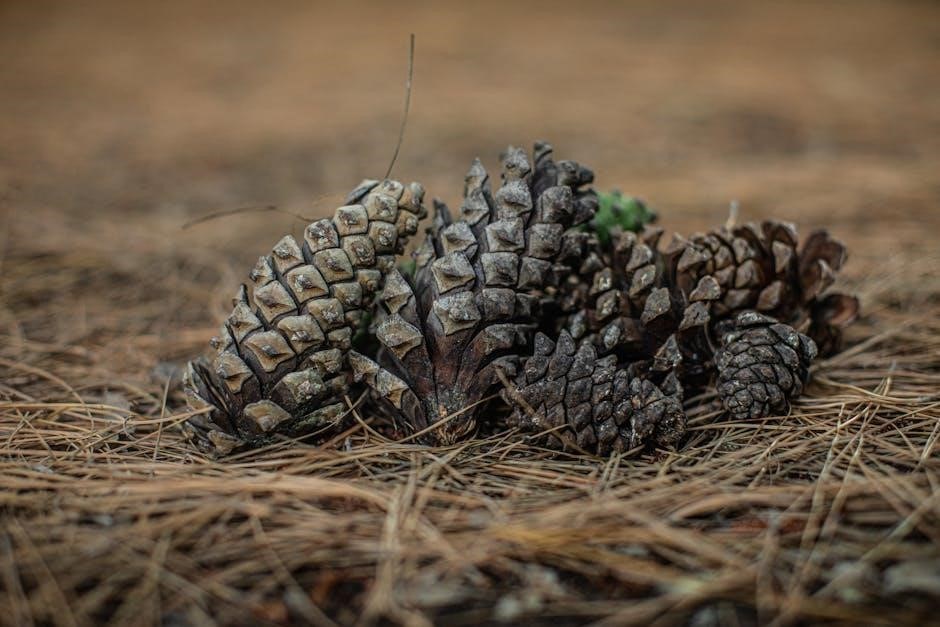manual of woody landscape plants
The manual provides a comprehensive guide to woody landscape plants, covering their identification, ornamental traits, and cultural practices. It serves as a cornerstone reference for professionals and enthusiasts, detailing the essential characteristics and uses of these plants in various landscapes.
1.1 Brief History of Woody Plants in Landscaping
Woody plants have been integral to landscaping for centuries, providing structure, shade, and beauty. Ancient civilizations used trees and shrubs for functional and aesthetic purposes. In modern times, their role expanded with advancements in horticulture and design. The Manual of Woody Landscape Plants highlights their historical significance, detailing how they’ve shaped landscapes across cultures and eras. This rich history underscores their enduring value in both traditional and contemporary designs, making them a cornerstone of landscape architecture.
1.2 Importance of Woody Plants in Modern Landscaping
Woody plants are indispensable in modern landscaping, offering aesthetic appeal, ecosystem services, and sustainability. They provide year-round structure, enhance biodiversity, and support wildlife habitats. Their durability and adaptability make them ideal for diverse environments. The Manual of Woody Landscape Plants emphasizes their role in creating functional and visually pleasing spaces, highlighting their ability to mitigate environmental challenges like urban heat islands. Their versatility ensures they remain a vital component of contemporary landscape design, blending functionality with natural beauty seamlessly.
1.3 Overview of the Manual of Woody Landscape Plants
Manual of Woody Landscape Plants is a definitive guide authored by Michael A. Dirr, detailing identification, ornamental traits, culture, propagation, and uses. It covers over 2,000 species and cultivars, offering insights for professionals and enthusiasts. The manual includes line drawings, diagnostic features, and practical advice, making it an essential resource for plant selection, sustainable landscaping, and ecosystem management. Its comprehensive approach ensures it remains a cornerstone in horticulture and landscape design education and practice, providing timeless value for all users.
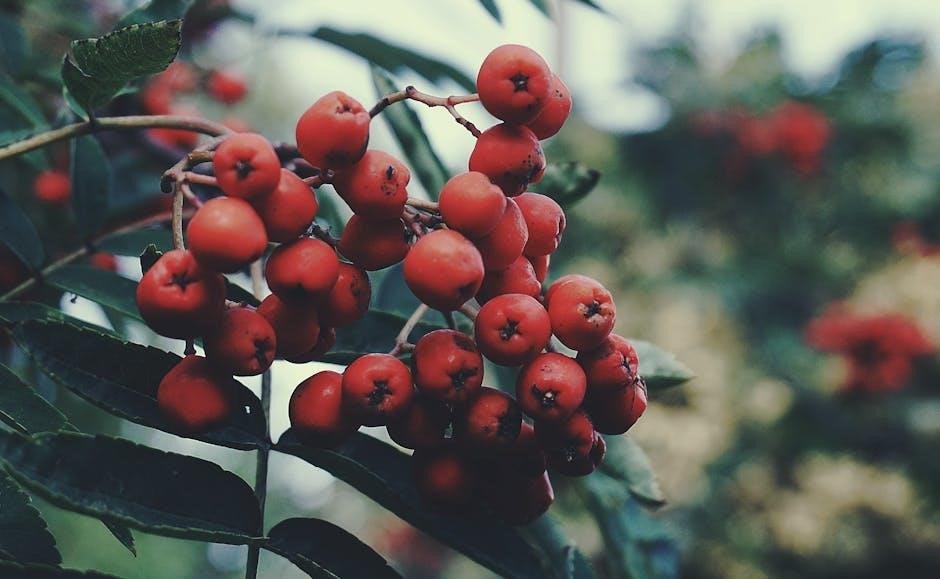
Identification of Woody Landscape Plants
Woody plants are identified through leaf morphology, bark patterns, stem characteristics, and seasonal features. This section details diagnostic traits and classification methods for accurate species recognition.
2.1 Classification of Woody Plants
Woody plants are classified based on growth habits, such as trees, shrubs, or vines, and by leaf morphology, including deciduous, evergreen, and coniferous types. Taxonomic classification involves genus and species designations, often grouped by plant families. This systematic approach aids in identification and understanding plant relationships. Classification also considers flowering and fruiting characteristics, enabling precise categorization for landscaping and horticultural purposes. Accurate classification is essential for proper plant selection and care in various environmental conditions.
2.2 Key Characteristics for Identification
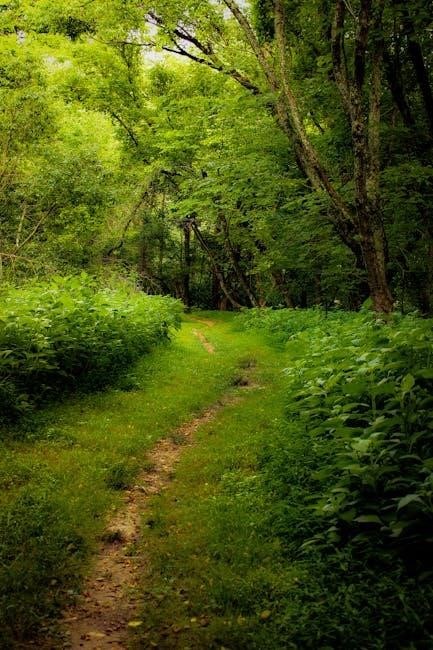
Key characteristics for identifying woody plants include leaf morphology, bark texture, stem structure, and the presence of flowers or fruits. Leaf shape, venation, and arrangement are critical diagnostic features. Bark patterns, such as peeling or ridging, also aid in identification. Stem thickness and growth habits, like branching patterns, provide additional clues. Flower and fruit types, including color, shape, and timing, further distinguish species. Seasonal variations in foliage and reproductive structures enhance accuracy in field identification, ensuring proper classification and application in landscaping or conservation efforts.
2.3 Leaf Morphology and Terminology
Leaf morphology involves studying shape, size, and venation patterns. Simple leaves are undivided, while compound leaves are divided into leaflets. Alternate and opposite arrangements describe how leaves attach to stems. Margins can be entire, serrated, or lobed, aiding identification. Venation patterns, such as pinnate or parallel, further distinguish species. Understanding these terms is essential for accurately identifying woody plants, as leaf traits are among the most visible and diagnostic features, varying significantly across species and influencing their ornamental and ecological roles in landscapes. Proper terminology enhances precision in classification and application.
2.4 Bark and Stem Characteristics
Bark and stem features are crucial for identifying woody plants. Bark textures vary from smooth to scaly or fissured, while colors may change with age. Stems exhibit unique growth patterns, such as upright, spreading, or climbing forms. Twig color, shape, and presence of lenticels (breathing pores) are diagnostic. Thorns or spines on stems can also aid identification. Understanding these traits helps distinguish species, as bark and stem characteristics often reflect a plant’s adaptation to its environment, providing valuable clues for accurate classification and landscape application.
2.5 Flower and Fruit Identification
Flowers and fruits are essential for identifying woody plants. Flowers vary in shape, size, and color, with some forming clusters or catkins. Fruits differ in structure, such as berries, nuts, or pods, and often provide clues for species recognition. The timing of flowering and fruiting, along with specific traits like seed arrangement, aids in accurate identification. These features are critical for distinguishing between similar species and understanding their ecological and ornamental value in landscapes.
2.6 Seasonal Changes and Diagnostic Features
Seasonal changes reveal unique diagnostic features in woody plants, such as autumn foliage color, flowering periods, and fruit ripening. These traits, along with bud formation and leaf senescence, provide critical clues for identification. Observing how plants adapt to seasonal shifts helps distinguish species and understand their growth patterns. These features are invaluable for landscape professionals, ensuring accurate identification and informed planting decisions throughout the year.
Ornamental Characteristics of Woody Plants
Woody plants enhance landscapes with diverse growth habits, foliage color, texture, and pattern, offering vibrant flowering displays and year-round appeal through seasonal changes and structural beauty.
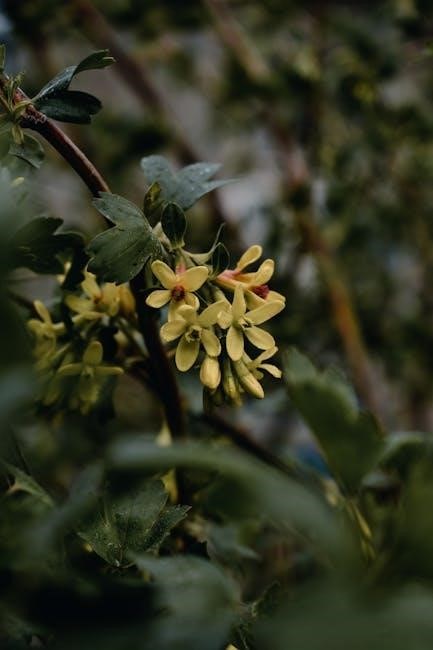
3.1 Growth Habits and Forms
Woody plants exhibit diverse growth habits, including upright, spreading, weeping, and compact forms. These variations allow for versatile landscaping applications, from formal hedges to naturalistic designs. Understanding growth patterns aids in selecting plants that fit specific spatial and aesthetic requirements, ensuring optimal use of space and visual harmony in gardens and outdoor spaces.
3.2 Foliage Color, Texture, and Pattern
Foliage is a key ornamental feature of woody plants, offering diverse colors, textures, and patterns. Colors range from deep greens to vibrant hues like gold, red, and purple, while textures vary from smooth to velvety or leathery. Patterns such as variegation add visual interest, creating striking contrasts. These traits enhance the aesthetic value of plants, making them versatile for landscape design and providing year-round appeal in gardens and outdoor spaces.
3.3 Flowering and Fruiting Displays
Woody plants offer vibrant flowering and fruiting displays, enhancing their ornamental value. Flowers vary in color, shape, and fragrance, attracting pollinators, while fruits like berries, nuts, and seed pods provide winter interest. These displays not only add beauty but also support wildlife, making them a key element in landscape design for both aesthetic and ecological benefits.
3.4 Seasonal Interest and Year-Round Appeal
Woody plants provide dynamic seasonal interest, with flowering in spring, vibrant foliage in summer, colorful fruits in fall, and striking bark or stems in winter. Their year-round appeal enhances landscapes by offering continuous visual engagement. Seasonal changes highlight their adaptability, making them versatile elements in garden design. This enduring beauty ensures woody plants remain a focal point throughout the year, adding depth and character to outdoor spaces.
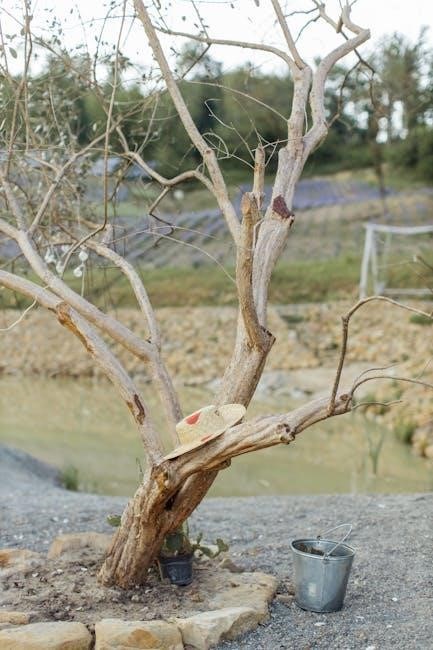
Cultural Requirements for Woody Plants
Woody plants require specific soil, water, sunlight, and nutrient conditions to thrive. Proper care includes pruning, mulching, and fertilization, ensuring healthy growth and longevity in landscapes.
4.1 Soil Preferences and Tolerances
Woody plants exhibit diverse soil preferences, ranging from acidic to alkaline conditions. Some species thrive in well-drained soils, while others tolerate wet or dry environments. Understanding these preferences is crucial for optimal plant health. For instance, certain shrubs prefer rich, loamy soils, whereas others adapt to sandy or clay-based substrates. Soil pH and nutrient availability also significantly influence growth. Selecting plants that match site-specific soil conditions ensures successful establishment and longevity in landscapes.
4.2 Watering Needs and Drought Tolerance
Woody plants vary in watering requirements and drought tolerance. Some species demand consistent moisture, while others adapt to arid conditions. Proper watering balances soil moisture to prevent over-saturation and root rot. Drought-tolerant plants often have deep root systems or waxy foliage. Understanding these needs ensures efficient irrigation practices, reducing water waste and promoting plant health. Matching plant species to site-specific water availability is key for sustainable landscaping and resource conservation.
4.3 Sunlight and Shading Requirements
Woody plants exhibit diverse sunlight and shading needs. Some thrive in full sun, requiring six or more hours of direct light, while others prefer partial shade or full shade. Incorrect light exposure can lead to poor growth or health issues. Understanding these requirements ensures optimal placement in landscapes. Proper site selection based on light conditions maximizes plant performance and aesthetic appeal, ensuring they flourish in their intended environments.
4.4 Fertilization and Nutritional Needs
Woody plants require balanced fertilization to thrive, with nutrient needs varying by species. Soil tests are essential to determine deficiencies and guide fertilizer selection. Slow-release formulations often provide sustained benefits. Over-fertilization can harm plants and soil health, so moderation is key. Timing is also critical, typically aligning with growth periods. Proper nutrition enhances foliage, flowering, and overall plant vigor, ensuring their longevity and aesthetic value in landscapes.
4.5 Pruning Techniques and Timing
Pruning is vital for maintaining shape, health, and productivity in woody plants. Techniques include thinning, reduction, and rejuvenation, each tailored to specific needs. Timing varies by species; most plants are pruned during dormancy to minimize stress. Tools should be sharp and clean to prevent disease spread. Over-pruning should be avoided to preserve plant vigor. Proper timing ensures optimal growth and flowering, while improper pruning can lead to reduced performance or susceptibility to pests and diseases.
4.6 Mulching and Soil Conservation Practices
Mulching is a key practice for soil health and conservation in woody landscapes. Organic mulches like wood chips or bark retain moisture, suppress weeds, and regulate soil temperature. Apply mulch 2-3 inches thick, keeping it away from plant stems to prevent rot. Mulching reduces soil erosion and enhances nutrient cycling. Regular replenishment maintains its benefits. Proper mulching techniques protect soil structure and promote root growth, ensuring long-term plant health and sustainable landscape management.
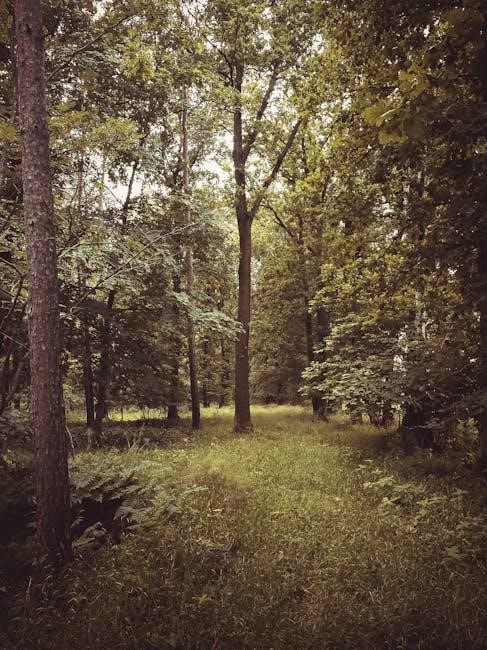
Propagation of Woody Landscape Plants
Woody landscape plants can be propagated through seeds, cuttings, layering, and grafting, ensuring plant diversity and sustainability in various landscaping projects and environments.
5.1 Sexual Propagation (Seeds)
Sexual propagation via seeds is a fundamental method for reproducing woody plants, ensuring genetic diversity. Seeds must be collected at maturity, stored properly, and stratified to break dormancy. Germination rates vary, requiring specific conditions. This method is ideal for species conservation and breeding new cultivars, though it can be time-consuming and less predictable compared to asexual techniques. Proper seed handling and storage are critical for successful germination and plant establishment.
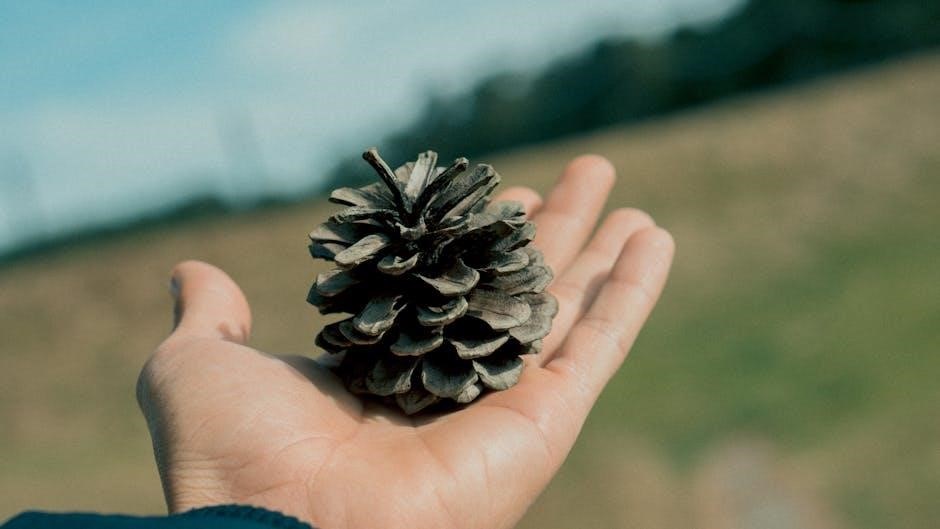
5.2 Asexual Propagation (Cuttings, Layering, Grafting)
Asexual propagation ensures genetic uniformity and faster results. Stem cuttings involve rooting sections of stems, often treated with hormones. Layering bends branches to touch the soil, promoting root development. Grafting combines a plant’s stem (scion) with another’s root system (rootstock) to enhance desired traits. These methods are widely used in nurseries for consistent plant production and preserving cultivar characteristics, offering reliable outcomes for woody plant multiplication.
5.3 Seed Collection and Storage Methods
Seed collection requires timing to ensure maturity. Harvest seeds when fruits or seed pods show signs of opening or color change. Clean seeds by removing pulp or debris, then dry thoroughly to prevent spoilage. Store in sealed containers in cool, dry places or refrigerate for longer viability. Proper techniques preserve germination rates and ensure healthy plant propagation, crucial for maintaining species integrity and diversity in landscaping projects.
5.4 Tips for Successful Propagation
Ensure cuttings are taken from healthy, disease-free plants. Use sharp tools to prevent tearing and promote healing. Maintain consistent moisture levels without overwatering. Provide adequate light and humidity for optimal rooting. Monitor temperature, as most species thrive between 65-75°F. Avoid contamination by using sterile equipment. Timing is critical; propagate during the growing season for best results. Proper care and attention significantly enhance rooting success and plant survival, leading to strong, vigorous new growth;

5.5 Tissue Culture and Advanced Propagation Techniques
Tissue culture involves growing plants from small tissue samples in controlled laboratory conditions. This method ensures rapid multiplication and genetic consistency. Advanced techniques like micropropagation and somatic embryogenesis are widely used for woody plants. These methods allow for large-scale production of high-quality plants. They are particularly useful for species that are difficult to propagate through traditional means. Tissue culture also reduces contamination risks and accelerates the breeding process, making it a valuable tool in modern horticulture and conservation efforts.
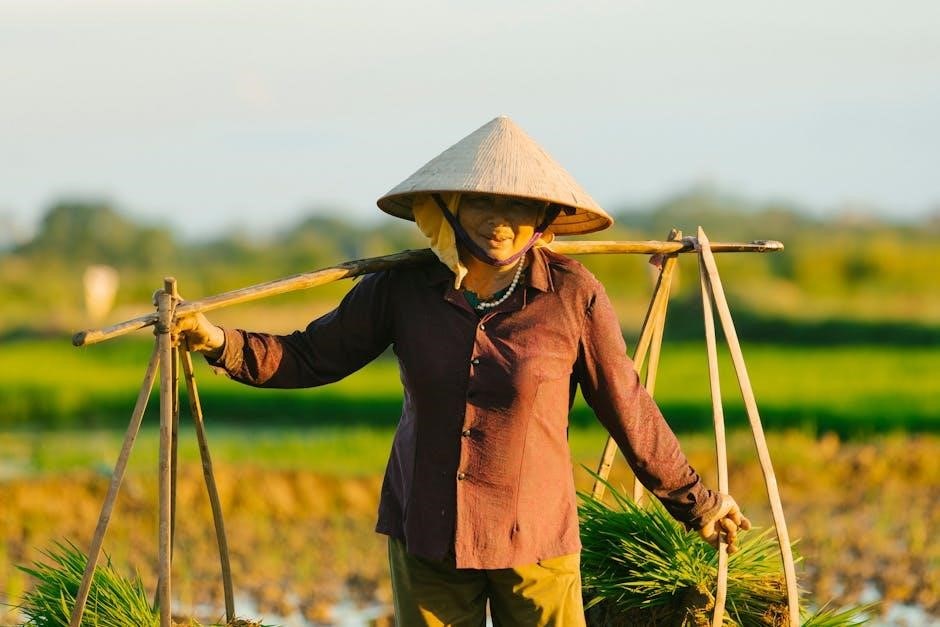
Uses of Woody Plants in Landscaping
Woody plants are essential for shade, erosion control, and aesthetic value. They provide habitats, enhance outdoor spaces, and serve as natural screens, improving landscapes’ functionality and beauty.
6.1 Ornamental Uses in Gardens and Parks
Woody plants add beauty and structure to gardens and parks through diverse forms, textures, and seasonal interest. Their vibrant foliage, flowers, and berries create stunning displays, enhancing visual appeal year-round. Trees and shrubs provide focal points, while hedges and topiaries offer artistic shapes. These plants also support biodiversity, making them invaluable for creating dynamic and ecologically rich outdoor spaces that inspire and delight visitors of all kinds.
6.2 Wildlife Support and Habitat Creation
Woody plants play a vital role in supporting wildlife by providing food, shelter, and nesting sites. Their berries, nuts, and foliage sustain birds, insects, and small mammals. Native shrubs and trees create habitats that attract pollinators and beneficial insects, promoting biodiversity. By incorporating woody plants, landscapes can serve as wildlife corridors, offering refuge and enhancing ecological balance. This support fosters thriving ecosystems, making these plants indispensable for wildlife conservation and habitat restoration efforts in both urban and natural settings.
6.3 Erosion Control and Soil Stabilization
Woody plants are instrumental in preventing soil erosion and stabilizing landscapes. Their extensive root systems bind soil particles, reducing runoff and landslides. Planting shrubs and trees on steep slopes or riverbanks helps anchor the soil, protecting against water and wind erosion. Native species are often ideal for such purposes due to their adaptability. Regular maintenance, like mulching, further enhances soil retention, making woody plants a practical and sustainable solution for ecological stability in challenging terrains.
6.4 Shade Provision and Microclimate Modification
Woody plants are essential for creating shade and modifying microclimates in landscapes. Trees with dense canopies provide significant shade, reducing summer heat and energy costs. Strategic planting can cool outdoor spaces, improve air quality, and protect sensitive plants from harsh sunlight. Additionally, woody plants buffer wind, mitigate extreme temperatures, and create habitats for wildlife, enhancing overall environmental comfort and biodiversity in urban and natural settings.
6.5 Hedging and Screening
Woody plants are widely used for hedging and screening due to their density and ability to provide privacy. Shrubs and small trees with compact growth habits are ideal for creating formal or informal boundaries. These plants also serve as visual barriers, blocking unwanted views while enhancing landscape aesthetics. Regular pruning maintains shape and density, ensuring effective screening. Their ornamental value adds beauty, making them functional and visually appealing in both residential and commercial settings.
6.6 Use in Native and Sustainable Landscapes
Woody plants play a crucial role in native and sustainable landscapes by promoting biodiversity and reducing environmental impact. Native species, such as oaks and maples, support local ecosystems by providing food and habitat for wildlife. Their deep root systems enhance soil health and prevent erosion. These plants require less maintenance and resources, making them ideal for eco-friendly designs. Incorporating native woody plants fosters sustainable landscapes that thrive with minimal intervention, aligning with conservation goals and environmentally responsible practices. They are essential for creating resilient and ecologically balanced environments.
Challenges and Considerations
Woody plants face challenges like pests, diseases, and environmental factors. Invasive species and maintenance requirements add complexity, necessitating careful selection and sustainable practices to ensure long-term health and stability.
7.1 Common Pests and Diseases of Woody Plants
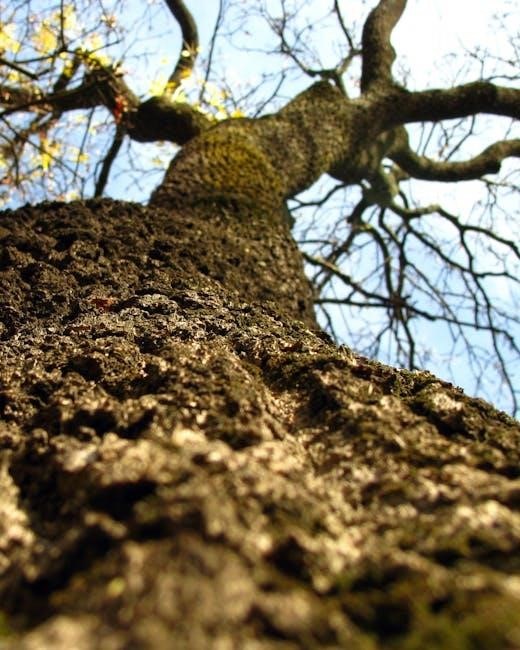
Woody plants are susceptible to various pests and diseases, such as aphids, scale insects, and fungal infections like powdery mildew. Regular monitoring is essential to detect early signs of infestation or infection. Proper sanitation, pruning, and the use of targeted pesticides or fungicides can help mitigate these issues. Understanding the specific vulnerabilities of different species is crucial for effective management. Preventative measures, such as ensuring healthy growing conditions, can reduce the risk of pest and disease outbreaks, promoting long-term plant health and resilience.
7.2 Managing Invasive Species
Invasive species pose significant threats to ecosystems by outcompeting native plants and disrupting biodiversity. Effective management requires early detection and removal of invasive woody species. Strategies include mechanical removal, targeted herbicides, and biological control methods. Restoring areas with native plants helps prevent reinvasion. Landowners and landscapers must avoid planting invasive species and instead choose non-invasive alternatives. Collaboration between stakeholders is essential to combat the spread of invasive species and protect environmental integrity. Regular monitoring and adaptive management plans are key to long-term success in controlling these harmful species.
7.3 Environmental Factors and Climate Adaptation
Environmental factors such as temperature, rainfall, and soil conditions significantly impact the growth and survival of woody plants. Climate change introduces additional challenges, including shifting precipitation patterns and increased frequency of extreme weather events. Understanding a plant’s climatic tolerance is crucial for successful landscaping. Soil preferences and watering needs must align with local environmental conditions to ensure plant health. Selecting species adapted to regional climates helps mitigate stress and supports sustainable landscape practices. This approach fosters resilience and long-term viability in dynamic environmental conditions.
7.4 Maintenance Requirements and Longevity
Maintenance requirements for woody plants vary by species, with factors like watering, pruning, and soil care playing key roles. Longevity depends on proper site selection and care practices. Regular pruning enhances health and structure, while matching species to site conditions ensures durability. Proper maintenance extends plant lifespan, reducing the need for frequent replacement. Understanding these needs helps create sustainable landscapes with thriving, long-lived woody plants that provide lasting beauty and ecological benefits. Regular care ensures their vitality and aesthetic appeal over time.
7.5 Ethical and Sustainable Plant Selection
Ethical and sustainable plant selection involves choosing species that minimize environmental impact while promoting biodiversity. Prioritizing native plants supports local ecosystems and reduces the risk of invasive species. Ethical sourcing ensures plants are propagated responsibly, avoiding harm to wild populations. Sustainable practices, such as water conservation and minimal chemical use, further enhance environmental stewardship. By selecting plants thoughtfully, landscapes can contribute to ecological balance and long-term sustainability, aligning with modern environmental values and responsible gardening practices.
Case Studies and Examples
Real-world applications of woody plants in landscaping are showcased through examples of successful residential gardens, urban plantings, and native restoration projects, demonstrating their versatility and benefits.
8.1 Successful Residential Landscapes
Residential landscapes often feature woody plants for beauty and functionality. Trees like oaks and maples provide shade, while shrubs such as hydrangeas add color. These plants enhance curb appeal, create privacy, and support local wildlife. Proper selection ensures year-round interest, with flowering trees in spring and evergreens in winter. Case studies highlight designs that blend aesthetics with sustainability, demonstrating how woody plants can transform outdoor spaces into inviting and ecologically friendly environments for homeowners.
8.2 Public Spaces and Urban Plantings
Woody plants play a vital role in enhancing urban landscapes, transforming public spaces into vibrant, sustainable environments. Trees like oaks and maples are often used in parks and streets for shade and beauty. Shrubs such as lilacs and roses add color and texture to plazas and walkways. These plantings improve air quality, reduce urban heat islands, and provide wildlife habitats. Case studies showcase successful urban designs, highlighting species selection and maintenance practices that promote biodiversity and create welcoming spaces for communities to gather and thrive.
8.3 Native Plant Restoration Projects
Native plant restoration projects emphasize the use of indigenous woody species to rehabilitate ecosystems, ensuring biodiversity and ecological balance. These initiatives often involve planting native trees and shrubs, such as oaks and dogwoods, to restore degraded habitats. The Manual highlights species suitability and propagation methods, aiding in the successful reestablishment of native flora. Case studies illustrate how such projects enhance wildlife support, improve soil health, and promote sustainable landscapes, serving as models for conservation efforts and environmental stewardship.
Woody plants remain vital for sustainable landscapes. Future trends include exploring new species, advanced propagation techniques, and climate-resilient designs, ensuring their continued relevance in eco-friendly horticulture and conservation.
9.1 The Role of Woody Plants in Future Landscapes
Woody plants will play a pivotal role in shaping future landscapes by enhancing biodiversity, mitigating climate change, and supporting wildlife. Their adaptability and aesthetic value make them indispensable in sustainable designs, offering shade, erosion control, and habitat creation. As urbanization grows, woody plants will be integral in creating resilient ecosystems. Their versatility ensures they remain central to both functional and ornamental landscaping, addressing environmental challenges while maintaining beauty.
9.2 Emerging Trends in Woody Plant Use
Emerging trends highlight a shift toward sustainable practices, emphasizing native plant species and climate-resilient varieties. Compact cultivars are gaining popularity for urban landscapes, offering space efficiency without sacrificing beauty. Additionally, there is a growing interest in using technology, such as plant selection apps, to optimize species choice for specific environments. These trends reflect a focus on environmental stewardship and adaptability, ensuring woody plants remain central to modern landscaping while addressing contemporary challenges.
9.3 The Importance of Conservation and Sustainability
Conservation and sustainability are vital for preserving woody plants, ensuring their role in ecosystems and landscapes endures. Protecting native species and reducing invasive plants are key priorities. Sustainable practices, like ethical plant sourcing and efficient water use, are increasingly emphasized. These efforts not only maintain biodiversity but also support long-term environmental health, making sustainable practices essential for future landscapes.
